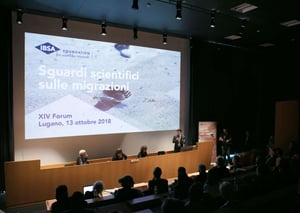On 13 October 2018 an original experiment was carried out in Lugano with the Forum “Scientific Views on Migration”: a current hot topic was taken and tackled from a scientific angle. Hence, an attempt was made to correctly reposition the phenomenon of migration using a multidisciplinary approach, starting with reliable data, sources and numbers, just like what would be done in any scientific investigation.
A clear picture, that in many ways was surprising, emerged from the contribution of geneticists, linguists, sociologists, anthropologists and jurists (not to mention philosophers, photojournalists and journalists). We have tried to identify the 11 most important considerations arising from an intense day of discussions. And here they are:
#1 Migration is not a predicament of modern times, it is a deep-rooted structural phenomenon concerning the last two million years. [Telmo Pievani, Full Professor of Philosophy of Biological Sciences – University of Padua, Italy]
What is happening today is the tail end of a long process. For two million years human populations have left their native continent, Africa, and migrated in all directions, differentiating themselves. Human beings have never stopped moving and the Mediterranean has always been the epicenter of this adaptive behavior. Currently the phenomenon of migration affects 68.5 million people, forced to leave their homes because of conflicts, discrimination, poverty or natural disasters.
The United Nations predict that climate change will be the primary cause of migration, and will peak in 2025: because of desertification, 50 million people will have to move to more fertile lands rich in water.
#2 The immigrant as a source of disease is a fantasy. The true reason for the spread of disease is tourism. [Bernardino Fantini, Honorary Professor of History of Medicine – University of Geneva, Switzerland]
In past centuries there was a constant relationship between the large-scale movement of people and epidemics, due to migration, war and geographical discoveries. This created an age-old fear of migrants, or foreigners in general, which still remains today.
Now, however, the situation has changed significantly as a result of globalization, which has greatly increased the movement of people and goods from one end of the earth to the other, for tourism and trade purposes, and at the same time has enabled public health to be monitored in a much more effective manner. In-depth studies have shown that migration is only responsible for a small percentage of the diseases arriving in Europe. These days the main vehicle for the spreading of diseases is, by far, tourism and trade.
#3 Poverty, safety, sustainable development and climate change are problems that must be solved together. [Mark Maslin, Professor of Climatology and Environmental Sciences – University College London (UCL), UK]
Climate change is not the driving force behind migration today: it is a multiplier, not the cause. Political, economic and social reasons play a decisive role, and in particular those linked to the availability of Energy, Food and Water. Climate change is connected to these elements and has an influence on migration and conflicts.
#4 Europe is the exporter and importer of people: in the last 5 centuries we have been exporters. [Guido Alfani, Associate Professor of History of Economy – Bocconi University, Milan, Italy]
Up to a few decades ago Europe was also a large “exporter” of migrants. In particular, Europe exported a good 54 million people from the beginning of the nineteenth century until the First World War, and again after the Second World War (from 1950 to 1970). Then, with economic growth, it became an “importer”.
#5 Migration is a human phenomenon that the law is required to regulate. [Pascal Mahon, Professor of Constitutional Law – University of Neuchâtel, Switzerland]
The concept of integration has become a key concept. At the start of the nineteenth century there was talk of “incorporation” in Switzerland. Now integration is the first step of the journey: first you integrate and then you can have access to citizenship. It is no coincidence that the law speaks of “successful integration”.
#6 There are two tools that limit the rights of migrants: the freedom to pursue an economy activity and the freedom to access social benefits. [Federica De Rossa Gisimundo, Assistant Professor of Economic Law – Università della Svizzera italiana, Lugano, Switzerland]
Is there a right to migration? A right to migration does exist, with legal rules that regulate its rights. It is this context that gives rise to a policy that swings between institutional impulses and democratic initiatives, social needs and economic contingencies.
#7 Not only people move, but also images. And images play a fundamental role in the construction of the phenomenon of migration. [Daria Pezzoli Olgiati, Professor for the Study and the History of Religion – University of Munich (LMU), Germany]
The migratory phenomenon is documented by many stereotypical images that circulate in newspapers and on TV programmes, the internet and social media.
Images do not only document a situation, they also form and characterize it, by implicitly and explicitly transmitting values and ideologies.
#8 Migration can be an educational, personal and collective element. [Giovanni Pellegri, Head of L’ideatorio – Università della Svizzera Italiana, Lugano, Switzerland]
Vivid images and fears, cultural influences and inevitable media bias play a role in our interpretation of the current migratory crisis.
The phenomenon of migration calls us, and our humanity, into question: the fragility of others questions us and reflects back on us.
#9 We are exposed to the trap of simplification. On the other hand, the applicable category is that of complexity. [Gianluca Grossi, Photographer, Bellinzona, Switzerland]
The work of a reporter is useful if it leads to the reflection and awareness of the complexity of the situation. Telling the story of the escape of a large number of human beings from conflicts can help to identify points of contact and points that overlap in the lives of those that are forced to leave and the lives of those that aren’t.
#10 In the last decade the world population of refugees has constantly increased. [Anja Klug, Head of the United Nations High Commissioner for Refugees (UNHCR) Office for Switzerland and Liechtenstein, Switzerland]
In this dramatic picture it is important to carefully assess the adequacy of the responses adopted by the European Union and its Member States. And to make the most of the potential for the progress of the current international protection regime in the recent Global Compact on Refugees agreement.
#11 It is easier to build a fair social system in a homogeneous society. [Federico Rampini, Journalist, Writer and News Correspondent of “La Repubblica” in New York]
We mustn’t turn a blind eye to the fact that there is an economic effect of immigration that puts poor white people in competition with migrants.
The cases of Sweden and America in the times of Roosevelt to Kennedy show that the times of closed borders have coincided with the greatest development of the welfare state. It is uncomfortable data, but data we have to deal with.

